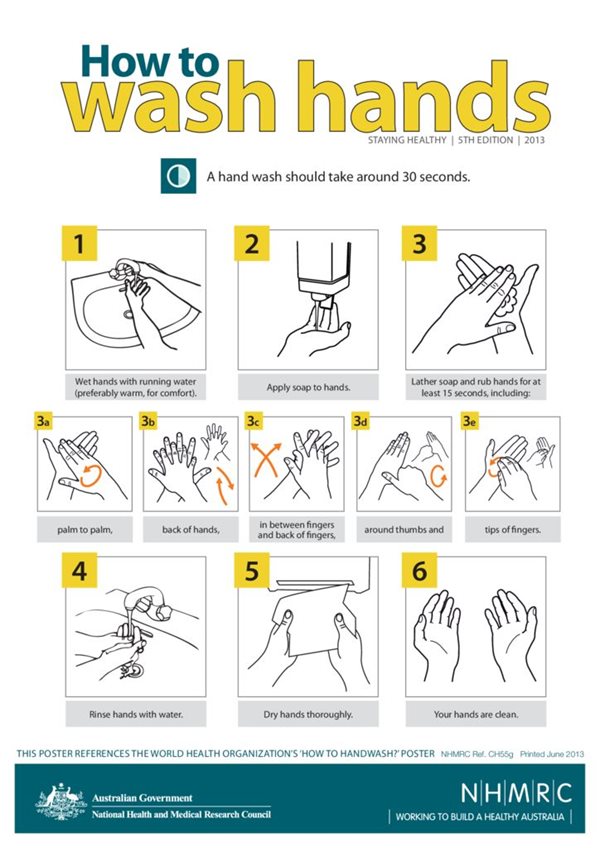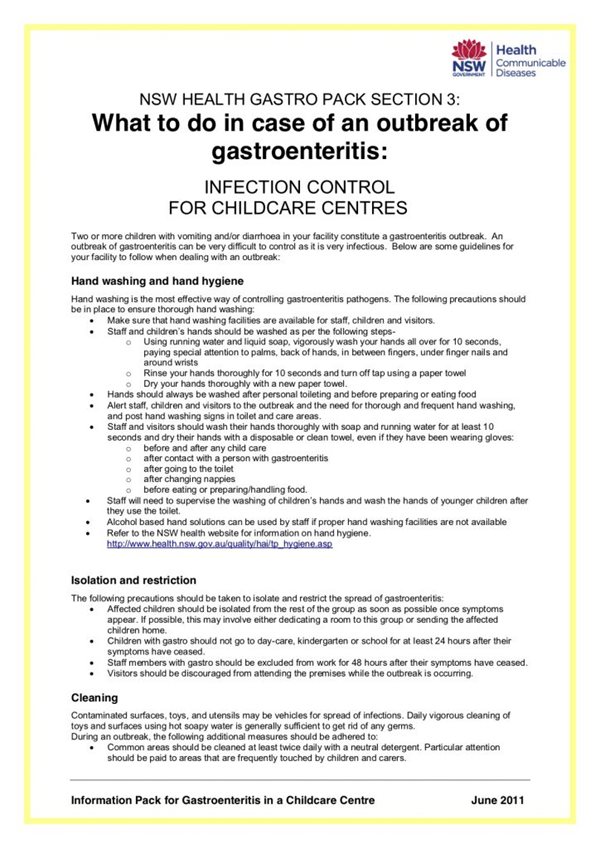Handwashing and drying might sound trivial to the uninitiated, but getting it right is a major action for reducing the spread of infectious diseases and staying healthy when working with children. This story is by CELA Writers Margaret Paton and Bec Lloyd
Along with curriculum and ethics, work safety and inclusion, there’s another core topic most professional educators learn: how to wash and dry their hands correctly and how to teach children to do the same.
Gastrointestinal (gastro) and respiratory infections (colds and flu) of children attending early learning or OSHC are frustratingly common.
Wherever human beings gather together, there’s a risk of contagion. When you add in a high level of physical contact (including toileting) and lower immunity among young children who haven’t yet been exposed to every common germ, you can expect to see an even higher rate of transmission.
Dangers to children
While far less common in developed countries with ready access to clean water, the Centre for Disease Control estimates:
About 1.8 million children under the age of 5 die each year from diarrheal diseases and pneumonia, the top two killers of young children around the world8.
- Handwashing with soap could protect about 1 out of every 3 young children who get sick with diarrhea2,3and almost 1 out of 5 young children with respiratory infections like pneumonia3,5.
- Although people around the world clean their hands with water, very few use soap to wash their hands. Washing hands with soap removes germs much more effectively9.
- Handwashing education and access to soap in schools can help improve attendance10,11,12.
- Good handwashing early in life may help improve child development in some settings13.
- Estimated global rates of handwashing after using the toilet are only 19%6.
In Australia, new parents are often warned by friends and family to expect a couple of years of ‘catching everything’ when their baby or toddler commences long day care, with the consolation that many families see fewer missed school days later on because of increased immunity built up through earlier illnesses.
As one of the ‘bibles’ of this sector, Staying Healthy, explains, good handwashing practices are the single most important thing you can do to reduce exposure to many infectious illnesses for yourself, your colleagues, the children and their families.
Handwashing in the NQF
Handwashing is a fundamental means of supporting the aims of the National Quality Framework, particularly Element 2.1.2. You can also read in the need for good handwashing practices in Regulation 88 and Regulation 168(2)(c) of the Education and Care Services National Regulations (last updated 1 July 2018).
In fact, the regulations say that if an approved provider doesn’t take ‘reasonable steps’ to ‘prevent the spread of … infectious disease’ after an outbreak, they face a penalty of $2000, and another penalty of $1000 applies if providers fail to have appropriate policies and procedures in place to prevent infectious diseases – of course, this includes the critical act of washing and drying hands.
Apart from the penalties, there’s an awareness day coming up to remind us all how important this is. With Global Handwashing Day approaching on October 15 this year, it’s a good time to think about how handwashing works in your service or office.
Have you found a balance around the sustainability around water use and drying options, for example? Do you have a song or transition habit for the children’s handwashing that reinforces the practice? Do you make it easy for families to be your partners so that handwashing practices at your service are mirrored at home, too?
How good are Australians at handwashing?
The Hand Hygiene Australia (HHA) organisation collects data nationally – but mostly from hospitals.
Its three-month audit to the end of June this year showed an 85% good handwashing compliance rate. However, HHA is happy with that result, because the National Hand Hygiene Benchmark (which the Australian Health Ministers’ Advisory Council have set) is 80%.
Their site has smartphone apps to enter hand hygiene audit data, and collect data on a mobile. Plus you can learn more about the issue and complete an online training module. There’s even a free annual Hand Hygiene Workshop, which is being held in Brisbane this year on 18 November.
What works?
Dutch researchers who took on this topic in early childhood centres found that explicit instructions and prompts for adults (more so than the children) were best practice. Their research showed when visible, practical interventions were developed to target educators’ compliance with hand washing, they worked.
The interventions included free refills of paper towels, soap, alcohol-based hand sanitiser and hand cream for six months.
The educators were also given more individual training, an information booklet, and team training to work out how they could further improve. The research showed that children’s handwashing habits also improved in the services being studied.
When to wash
There are several credible resources to help you form or update your service’s policy and practices. Apart from Staying Healthy, the Australian Government’s Health Direct website has a good overview for anyone (not just people working with children) on when you need to wash your.
We’ve combined that list with other reputable sources to create this summary:
- on arriving and leaving your service
- when your hands are visibly dirty
- after going to the toilet
- after helping a child go to the toilet, or changing a nappy
- after handling rubbish, household or garden chemicals, or anything that could be contaminated
- before you prepare or eat food or handle a baby’s bottle
- after touching raw meat
- after wiping/blowing your nose or sneezing
- after patting an animal
- after cleaning up or touching sores, a wound/cut, blood, vomit or other body fluids or faeces
- after removing gloves
- before and after giving medication
- after playing outside
How to wash
Here’s the National Health and Medical Research Council’s six steps in a downloadable poster.

The key to good handwashing is time – around 30 seconds is the current recommendation, which is about the time it takes to sing two rounds of the Happy Birthday To You song.
The kinds of soap you use might vary according to special needs in your service for skin sensitivities or for the physical set up in your bathrooms and kitchens.
Be aware, though, that hand sanitiser is not recommended as a substitute for handwashing. Bacteria are clever at avoiding death-by-disinfectant and hand sanitisers are reportedly losing their effectiveness against some germs.
Read this recent NPR report for the story of how hand sanitisers in Australian hospitals may have actually increased the spread of some diseases.
A handwashing song (If you’re happy and you know it tune)
How to dry
As for hand drying, paper towels are favoured by most of the sources we consulted. Take a look at NSW Health’s Gastro Pack advice about controlling infections in the early learning sector. We’ve included an extract below.

But it’s not all clear cut. A study in the international Infection, Disease & Health journal found children who dried their hands with a retractable cloth towel and a warm air dryer significantly reduced “bacterial numbers translocating to skin, food or a toy”.
Meanwhile, WorkSafe Western Australia’s Guidance Note on Reducing the Risk of Infectious Disease in Child Care Workplaces suggests using a paper towel or dryer. And a study from the Mayo Clinic in the USA comes out strongly recommending paper towels ‘in locations where hygiene is paramount, such as in hospitals and clinics’. That’s also endorsed by this researcher from the United Kingdom who completed a peer-reviewed study.
Sustainability balancing act
However, paper towels kill trees! So when handwashing appears in a service’s sustainability policy, it’s not unusual to see something like this approach we are quoting from Goolwa Children’s Centre in South Australia:
…where relevant, review policies and procedures within the service to find more sustainable outcomes, eg using hand dryers or washers instead of paper towel to dry hands.
It can be tricky to find a balance for two important outcomes – sanitation and sustainability – and like many other aspects of your professional procedures, where there is evidence backing a number of possible approaches you may just have to choose which is the best ‘fit’ for your service and your community.
And when in doubt, you can always turn to the Wiggles! The is a resource sheet here, and a UNICEF promoted video here.
Share your handwashing and drying habits with us in the comments – how are you doing it differently than in the past?
Related articles and resources